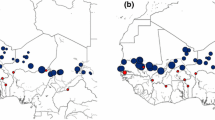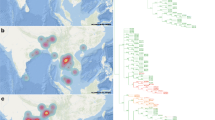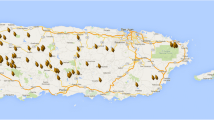Abstract
Spontaneous gene flow between wild and cultivated chicory, Cichorium intybus L., may have implications for the genetic structure and evolution of populations and varieties. One aspect of this crop-wild gene flow is the dispersal of transgenes from genetically modified varieties, e.g. gene flow from GM chicory to natural chicory could have unwanted consequences. With the purpose to identify and quantify crop-wild gene flow in chicory, we analysed introgression in 19 wild chicory populations and 16 accessions of chicory varieties and landraces distributed across Northern, Central and Mediterranean Europe. The analysis used 281 AFLP markers and 75 SSAP markers giving a total of 356 polymorphic markers. Results from model based assignments with the program STRUCTURE indicated many incidents of recent gene flow. Gene flow was observed both between cultivars and wild populations, between landraces and wild populations, between different wild populations as well as between cultivars. Population structure visualized by distance-based clustering showed a North–South geographical structuring of the wild populations, and a general grouping of the cultivars corresponding to known origin. The results indicated, however, that the structuring between the two groups of wild and cultivated types was weak. As crop and wild recipients are genetically close and genes are transferred between the two types rather frequently, focus on mitigating crop-wild gene flow should be increased, before transgenic varieties are cultivated openly.






Similar content being viewed by others
References
Andersen NS, Poulsen G, Andersen BA, Kiær LP, D’Hertefeldt T, Wilkinson MJ, Jørgensen RB (2008) Processes affecting genetic structure and conservation—a case study of wild and cultivated Brassica rapa. Genet Resour Crop Evol. doi:10.1007/s10722-008-9354-6
Bonin A, Bellemain E, Bronken Eidesen P, Pompanon F, Brochmann C, Taberlet P (2004) How to track and assess genotyping errors in population genetics studies. Mol Ecol 13:3261–3273
Doyle JJ, Doyle JL (1987) A rapid DNA isolation procedure for small quantities of fresh leaf tissue. Phytochem Bull 19:42309
Eenink AH (1981) Compatibility and incompatibility in witloof-chicory (Cichorium intybus L.). 2. The incompatibility system. Euphytica 30:77–85
Ellstrand NC (2001) When transgenes wander, should we worry? Plant Physiol 125:1543–1545
Ellstrand NC, Prentice HC, Hancock JF (1999) Gene flow and introgression from domesticated plants into their wild relatives. Annu Rev Ecol Syst 30:539–563
Evanno G, Regnaut S, Goudet JG (2005) Detecting the number of clusters of individuals using the software STRUCTURE: a simulation study. Mol Ecol 14:2611–2620
Excoffier L, Smouse PE, Quattro JM (1992) Analysis of molecular variance inferred from metric distances among DNA haplotypes: application to human mitochondrial DNA restriction data. Genetics 131:479–491
Felsenstein J (1993) PHYLIP, Phylogenetic inference package, version 3.5.7. A computer program distributed by the author. Department of genetics, University of Washington, Seattle, USA. Available from http://evolution.genetics.washington.edu/phylip.html
Fjellheim S, Rognli OA (2005) Genetic diversity within and among Nordic meadow fescue (Festuca pratensis Huds.) cultivars determined on the basis of AFLP markers. Crop Sci 45:2081–2086
Gemeinholzer B, Bachmann K (2005) Examining morphological and molecular diagnostic character states of Cichorium intybus L. (Asteraceae) and C. spinosum L. Pl Syst Evol 253:105–123
Johannessen MM, Mikkelsen TN, Jørgensen RB (2002) CO2 exploitation and genetic diversity in winter varieties of oilseed rape (Brassica napus); varieties of tomorrow. Euphytica 128:75–86
Kiær LP, Philipp M, Jørgensen RB, Hauser TP (2007) Genealogy, morphology and fitness of spontaneous hybrids between wild and cultivated chicory (Cichorium intybus). Heredity 99:112–120
Kiers AM (2000) Endive, chicory and their wild relatives. A systematic and phylogenetic study of Cichorium (Asteraceae). Gorteria Suppl 5:1–78
Legendre P, Makarenkov V (2002) Reconstruction of biogeographic and evolutionary networks using reticulograms. Syst Biol 51:199–216
Lynch M, Milligan BG (1994) Analysis of population genetic structure with RAPD markers. Mol Ecol 3:91–99
Makarenkov V, Legendre P (2004) From a phylogenetic tree to a reticulated network. J Comput Biol 11:195–212
Pritchard JK, Stephens M, Donnelly P (2000) Inference of population structure using multilocus genotype data. Genetics 155:945–959
Reynolds J, Weir BS, Cockerham CC (1983) Estimation for the co-ancestry coefficient: basis for a short-term genetic distance. Genetics 105:767–779
Rick CM (1953) Hybridization between chicory and endive. Proc Am Soc Hort Sci 61:459–466
Rosenberg NA, Burke T, Elo K, Feldman MW, Freidlin PJ, Groenen MAM, Hillel J, Mäki-Tanila A, Tixier-Boichard M, Vignal A, Wimmers K, Weigend S (2001) Empirical evaluation of genetic clustering methods using multilocus genotypes from 20 chicken breeds. Genetics 159:699–713
Rosenberg NA, Pritchard JK, Weber JL, Cann HM, Kenneth KK, Lev A, Zhivotovsky LA, Feldman MW (2002) Genetic structure of human populations. Science 298:2381–2385
Ryder EJ (1999) Lettuce, endive and chicory. Crop production science in horticulture, vol 7. CABI Publishing, CAB International, New York
Saitou N, Nei M (1987) The neighbor-joining method: a new method for reconstructing phylogenetic trees. Mol Biol Evol 4:406–425
Schoofs J, de Langhe E (1988) Chicory (Cichorium intybus L.). In: Bajaj YPS (ed) Biotechnology in agriculture and forestry, vol 6. Crops II. Springer-Verlag, Berlin/Heidelberg
Shim SI, Jørgensen RB (2000) Genetic structure in cultivated and wild carrots (Daucus carota L.) revealed by AFLP analysis. Theor Appl Genet 101:227–233
Simmonds NW (1976) Evolution of crop plants. Longman, London
Sørensen BS, Kiær LP, Jørgensen RB, Hauser TP (2007) The temporal development in a hybridizing population of wild and cultivated chicory (Cichorium intybus L.). Mol Ecol 16:3292–3298
Syed NH, Flavell AJ (2007) Sequence-specific amplification polymorphisms (SSAPs): a multi-locus approach for analyzing transposon insertions. Nat Protoc 1:2746–2752
Syed NH, Sureshsundar S, Wilkinson MJ, Bhau BS, Cavalcanti JJV, Flavell AJ (2005) Ty1-copia retrotransposon-based SSAP marker development in Cashew (Anacardium occidentale L). Theor Appl Genet 110:1195–1202
Van Cutsem P, du Jardin P, Boutte Beauwens T, Jacqmin S, Vekemans X (2003) Distinction between cultivated and wild chicory gene pools using AFLP markers. Theor Appl Gen 107:713–718
Vekemans X (2001) AFLPsurv V.1.0. A software for genetic diversity analysis with AFLP population data, distributed by the author, xvekema@ulb.ac.be, Université Libre de Bruxelles
Vos P, Hogers R, Bleeker M, Reijans M, van de Lee T, Hornes M, Friters A, Pot J, Paleman J, Kuiper M, Zabeau M (1995) AFLP: a new technique for DNA fingerprinting. Nucleic Acids Res 23:4407–4414
Zhivotovsky LA (1999) Estimating population structure in diploids with multilocus dominant DNA markers. Mol Ecol 8:907–913
Acknowledgements
The EU project ANGEL, “Analysis of gene flow from crop to wild forms in lettuce and chicory and its population-ecological consequences in the context of GM-crop biosafety”, QLK3-CT-2001-01657, supported this work. F. Felber and R. Guadagnuolo were partially funded by the National Centre of Competence in Research (NCCR) Plant Survival, research programme of the Swiss National Science Foundation. We thank Anouk Béguin for help with the analyses and Dr. Guillaume Besnard for technical support.
Author information
Authors and Affiliations
Corresponding author
Rights and permissions
About this article
Cite this article
Kiær, L.P., Felber, F., Flavell, A. et al. Spontaneous gene flow and population structure in wild and cultivated chicory, Cichorium intybus L.. Genet Resour Crop Evol 56, 405–419 (2009). https://doi.org/10.1007/s10722-008-9375-1
Received:
Accepted:
Published:
Issue Date:
DOI: https://doi.org/10.1007/s10722-008-9375-1




